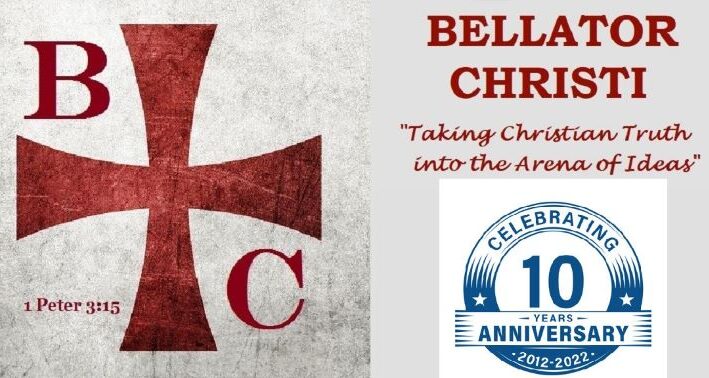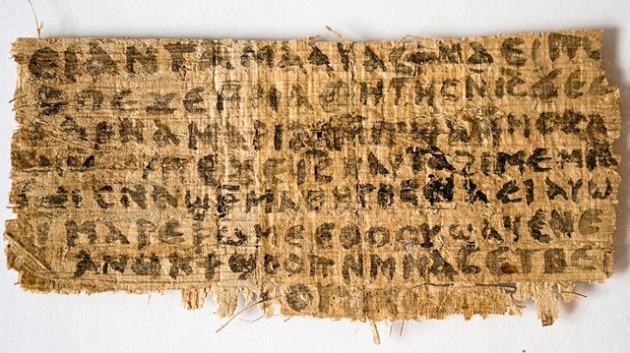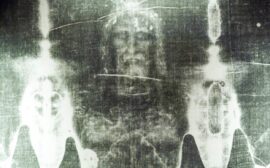Recent tests reveal that the fragment from what has been termed the Gospel of Jesus’ Wife is an authentic find and not a modern forgery as many have suggested. The fragment contains a reference to Jesus speaking of His wife and claiming that she was one of the disciples. It is the scandalous type of stuff that one would expect from a Dan Brown novel. Karen King, the person who discovered the fragment, said “’The Gospel of Jesus’s Wife’ doesn’t prove that Jesus was married but sheds light on early Christians’ discussions about whether ‘the ideal mode of Christian’ life was a celibate one” (Boorstein 2014, Washington Post).
Of course when a discovery like this is made, the skeptics come out of the woodwork. For instance Hal Taussig, a New Testament professor who worked with King, took the issue a step farther than King when he said that “he believes the document is ancient and ostensibly as important as documents that make up the accepted New Testament…’Everything we have is a copy of a copy of a copy. We have no original documents…what you have are traditions of writings'” (Boorstein 2014, Washington Post). A few things need to be addressed concerning non-biblical writings and their comparison to the New Testament manuscripts.
Date of New Testament Manuscripts vs. Non-Canonical Manuscripts
Without going in great depth pertaining to the comment of Hal Taussig, it should be noted that the New Testament manuscripts date well within the first-century, some including the Gospel of Mark and 1 Corinthians, date well into the early part of the first-century. Concerning the issue of copies and dating, Norman Geisler writes,
New Testament manuscripts are now available from the third and fourth centuries, and fragments that may date back as far as the late first century. From these through the medieval centuries, the text remained substantially the same. There are earlier and more manuscripts for the New Testament than for any other book from the ancient world. While most books exist in ten or twenty manuscripts dating from a thousand years or more after they were composed, one nearly entire manuscript, the Chester Beatty Papyri, was copied in about 250. Another manuscript with the majority of the New Testament, called Vaticanus, is dated to about 325 (Geisler BDCA 1999, 93).
The fragment of the Gospel of Jesus’ Wife dates to the “eighth-century” (Harvard.edu) which is far removed from the texts of the New Testament which date to the first-century. Even if the text came from an original dating to the fourth-century, it is far removed from the time of Jesus as opposed to the New Testament manuscripts which preserve early traditions and sayings of Jesus which some, as in the case of the formulation found in 1 Corinthians 15:3-9, date to the time of Christ.
Sects Surrounding New Testament Manuscripts vs. Sects Surrounding Non-Canonical Manuscripts
The key behind this discovery is learning more about early Christian sects…or those who claim to be “Christian.” In reality, the idea that Jesus was married is not a new. In an interview conducted by Kevin Emmert, non-canonical gospel scholar Nicolas Perrin states,
In the Coptic, the phrase really says, “Jesus said to them, ‘My woman…'” It could mean “woman” in the generic sense, but I think it just means his wife. The word is chime, which in this context, I think, means “wife.” And then it goes on to say, “she will be my disciple.” To me, this seems most reminiscent of another text dated to the third century AD, called The Gospel of Philip.
In the Gospel of Philip, there are intimations of Jesus being married, or at least having a partner. The Coptic term is a little ambiguous, at least regarding Mary. It’s a mysterious text, but what’s going on, to the best of our knowledge, in the Gospel of Philip is that Jesus and Mary are reconstituting a kind of mythic primeval androgyny. What the folks behind the Gospel of Philip are saying about Jesus is that he is the new Adam and Mary is the new Eve. And the whole point about redemption is to get male and female together once again (in my interpretation), but this time without sexual intercourse.
I believe the Gospel of Philip represents a sect where men and women cohabitated and followed Jesus, but forbade sexual intercourse within what would otherwise be a marriage relationship. So the Gospel of Jesus’ Wife fragment could give theological warrant to that (Emmert 2014, CT).
Everett Ferguson points out in his textbook on the history of Christianity,
Asceticism in varying degrees of self-denial (in matters of marriage and diet) had been practiced by some Christians from the earliest days of the church…In contrast…early asceticism did not regard matter as evil…Many females adopted the ascetic life, something obscured by the fact that most of the literature was written by males for males (Ferguson 2005, 228).
With this knowledge, it would seem that groups less inclined to orthodoxy would pseudonymously write books that would verify their practices. This would seem to be the case with The Gospel of Jesus’ Wife as well as The Gospel of Philip, The Gospel of Thomas, and so on.
Conclusion:
Nothing is really proven by this finding other than the fact that there existed unorthodox versions of Christianity early in Christian history. What becomes problematic is when scholars and individuals purport such finding as the Gospel of Jesus’ Wife as being on equal par with the New Testament documents. Note that Karen King, the discoverer of the fragment, never makes such a claim. It is only those who wish to gain notoriety or lots of money from a scandal that ever claim as much. One must wonder about the level of scholarship and honesty from those who make such assertions. Someone once said, “Controversy creates cash.” It is unfortunate when such a mentality enters the realm of biblical scholarship. Perhaps the most scandalous of all is the reality that Christianity is built upon a firm foundation. For some, confirming the Christian message brings more ire and annoyance than claiming that defacing the American flag.
Bibliography
Boorstein, Michelle. “Harvard journal says ‘Gospel of Jesus’s Wife’ is ancient, not a modern forgery.” Washington Post.com. (April 10, 2014). http://www.washingtonpost.com/national/harvard-journal-says-gospel-of-jesus-wife-is-ancient-not-a-modern-forgery/2014/04/10/7b172910-c0f7-11e3-bcec-b71ee10e9bc3_story.html. (Accessed April 14, 2014).
Emmert, Kevin P. “How to date Jesus’ wife: New tests suggest a manuscript fragment is ancient after all…” Christianity Today.com. (April 11, 2014). http://www.christianitytoday.com/ct/2014/april-web-only/gospel-of-jesus-wife-nicholas-perrin.html?paging=off. (Accessed April 14, 2014).
Ferguson, Everett. Church History: Volume 1—From Christ to Pre-Reformation. Grand Rapids: Zondervan, 2005.
Geisler, Norman L. Baker Encyclopedia of Christian Apologetics, Baker Reference Library. Grand Rapids, MI: Baker Books, 1999.
Harvard University. http://gospelofjesusswife.hds.harvard.edu/QA. (Accessed April 14, 2014).





